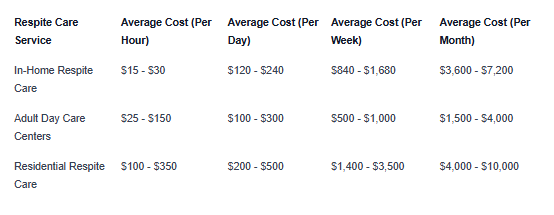What is the Average Cost of Respite Care?
March 5, 2025
Unveil the average cost of respite care and navigate funding options with expert insights for your peace of mind.


Understanding Respite Care

Respite Care provides temporary relief to caregivers by offering short-term care services for individuals who require assistance with daily activities. It allows caregivers to take a break from their responsibilities, recharge, and attend to their own well-being.
What is Respite Care?
Respite Care, also known as short-term care, provides caregivers with the opportunity to have a temporary and brief relief from their caregiving duties. During this time, individuals in need of care receive support and assistance from trained professionals in a facility or at home. Respite Care services can range from a few hours to several days, depending on the caregiver's needs and the individual's care requirements.
Importance of Respite Care for Caregivers
Respite Care plays a crucial role in supporting the well-being of caregivers. It offers a much-needed break from the demanding and often overwhelming responsibilities of caregiving. By taking time to rest and recharge, caregivers can prevent burnout, reduce stress, and enhance their overall mental and physical health.
Moreover, Respite Care allows caregivers to engage in self-care activities, pursue personal interests, and maintain social connections. This period of respite can help caregivers feel rejuvenated and better equipped to continue providing quality care to their loved ones in the long run.
Understanding the significance of Respite Care is essential for caregivers to prioritize their own health and well-being while ensuring that their loved ones receive the necessary support and care during times of respite.
Factors Affecting Respite Care Costs

When considering respite care options, it's essential to understand the key factors that can influence the associated costs. Two primary factors that significantly impact the cost of respite care are the location of the facility and the level of care needed.
Location and Facility Type
The location of the respite care facility plays a major role in determining the cost of care. Urban areas and regions with a higher cost of living typically have more expensive respite care services compared to rural areas. The type of facility, whether it's a nursing home, assisted living facility, or in-home care, can also affect the overall cost. Each facility type offers different amenities and services, which can influence the price of respite care.
Level of Care Needed
The level of care required by the individual receiving respite services is another critical factor in determining the overall cost. Individuals with complex medical needs or those requiring specialized care, such as dementia or Alzheimer's care, may incur higher expenses compared to those needing basic supervision or personal care assistance. The more intensive and specialized the care needed, the higher the cost of respite services is likely to be.
Understanding how location and facility type, as well as the level of care needed, impact respite care costs can help individuals and caregivers make informed decisions when planning for respite care services. By considering these factors carefully, individuals can anticipate and budget for the expenses associated with respite care, ensuring that their loved ones receive the necessary support while managing financial resources effectively.
Average Cost of Respite Care
When exploring the average expenses associated with respite care, it is essential to consider both the national average cost and the factors that contribute to the variability in these expenses.
National Average Cost of Respite Care
The national average cost of respite care can vary significantly based on factors such as location, facility type, level of care required, and duration of care. Below is a general overview of the average costs for respite care services:

It is important to note that these figures are approximate and can vary based on the specific amenities and services provided by the care facility.
Factors That Influence Cost Variability
Several factors can influence the variability in respite care costs, making it essential to understand the following aspects:
- Location: Respite care costs can differ based on the region or city where the services are being provided. Urban areas tend to have higher costs compared to rural areas.
- Facility Type: The type of respite care facility, such as in-home care, adult day care centers, or residential care facilities, can impact the overall cost. Each facility offers distinct services that may affect the pricing.
- Level of Care Needed: The complexity of care required by the individual receiving respite services affects the overall cost. Those needing specialized care or medical assistance may incur higher expenses.
- Duration of Care: The length of time for which respite care services are utilized can also influence the total cost. Short-term respite care options may have different pricing structures compared to long-term care arrangements.
By understanding the national average costs of respite care services and the factors that contribute to cost variability, individuals and caregivers can make informed decisions regarding budgeting and planning for respite care expenses. It is important to conduct thorough research and consider all relevant factors when estimating the financial aspects of respite care.
Funding Options for Respite Care
When it comes to covering the costs of respite care, there are several funding options available to individuals and caregivers. Understanding these funding avenues is essential in ensuring adequate support for those in need of respite care services. Two common funding options for respite care include Medicare and Medicaid coverage, as well as long-term care insurance.
Medicare and Medicaid Coverage
Medicare Coverage:
Medicare may provide coverage for some respite care services under specific conditions. While Medicare typically does not cover long-term residential care, it may cover short-term respite care in certain situations. This can offer caregivers a much-needed break while ensuring that their loved ones receive the necessary care in their absence.
Medicaid Coverage:
Medicaid, on the other hand, may offer more extensive coverage for respite care services, particularly for individuals with limited financial resources. Each state administers its Medicaid program, so coverage details can vary. Medicaid may cover respite care in various settings, including home-based care and facility-based care, based on individual eligibility criteria.
Long-Term Care Insurance
Long-term care insurance is another funding option that individuals can consider to help cover the costs of respite care. This type of insurance is designed to cover expenses related to long-term care services, including respite care, in-home care, and nursing home care. Long-term care insurance can provide financial assistance to individuals who require respite care services and wish to protect their savings and assets from being depleted by care expenses.
By exploring funding options such as Medicare and Medicaid coverage, as well as long-term care insurance, individuals and caregivers can make informed decisions regarding the financial aspects of respite care. It is advisable to consult with insurance providers, government agencies, and financial advisors to understand the specifics of each funding option and determine the best approach to cover the costs of respite care effectively.
Planning for Respite Care Costs
When it comes to arranging respite care for your loved one, understanding and planning for the associated costs are essential. Here we delve into budgeting for respite care expenses and avenues for seeking financial assistance.
Budgeting for Respite Care Expenses
Budgeting for respite care expenses involves carefully evaluating the financial aspects of accommodating this crucial service. To assist in this process, consider creating a budget that outlines the expected costs of respite care based on the frequency and duration of care needed.

Understanding the average costs associated with different types of respite care services can help you estimate the overall expenses and plan your budget accordingly. It's advisable to include potential additional costs such as transportation, medical supplies, and any specific care requirements in your budgeting calculations.
Seeking Financial Assistance
If the costs of respite care present a financial challenge, there are several avenues to explore for financial assistance. Some potential options include:
- Medicare and Medicaid Coverage: Depending on eligibility criteria and the specific services needed, Medicare and Medicaid may offer coverage for respite care services. It is advisable to check with these programs to understand the extent of coverage available.
- Long-Term Care Insurance: Individuals with long-term care insurance policies may be able to utilize their benefits to cover respite care expenses. Review your policy details to determine if respite care services are included and the extent of coverage provided.
- Local and State Assistance Programs: Various local and state assistance programs may offer financial aid or subsidies for respite care services. Researching and reaching out to these programs can provide additional support in managing the costs of respite care.
Exploring these financial assistance options can help alleviate the financial burden associated with respite care, making it more accessible and manageable for families and caregivers. By proactively planning for respite care costs and seeking financial assistance where possible, caregivers can ensure that their loved ones receive the essential care they need while maintaining financial stability.
Sources
https://www.seniorliving.org/respite/costs/
https://www.forbes.com/health/healthy-aging/respite-care/
https://www.healthline.com/health/respite-care













